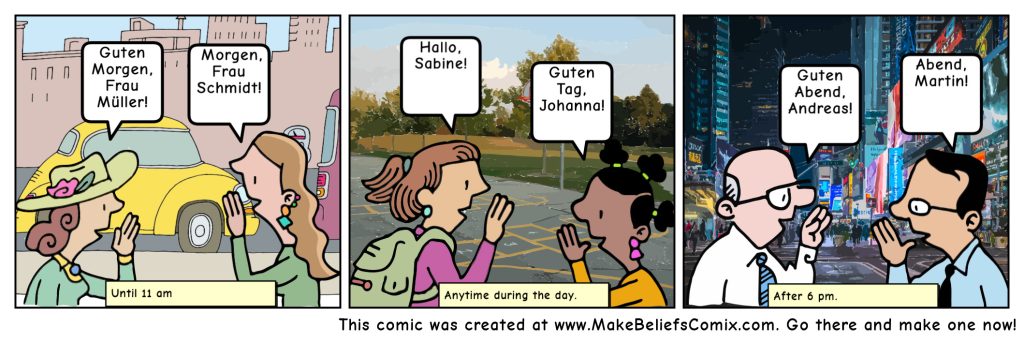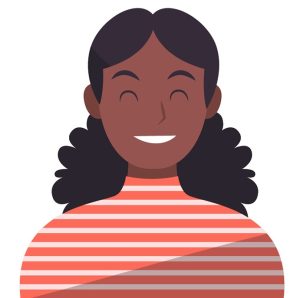1.1 Hallo! Ich heiße…

Guten Tag!
Let’s warm up with a brief bit of small talk (Tagesminiplausch ).
Lektionsüberblick (Lesson overview)
In this first lesson, we are working on introducing ourselves. We will also get a tiny taste of the country of Austria (Österreich) as we learn a few greetings in Austrian German. In the end, you will be able to 1) greet someone in German, 2) say your name, and 3) say your pronouns. Let’s get started!
1) How to greet someone in German
You don’t know it, but you already know a lot of German. Since English is a Germanic language, you can recognize many words. Plus, by looking at the texts below, you can use your expectation to anticipate what is being said, even if you don’t understand all the individual words. Can you tell which word is the greeting in each text? Use the activity beneath the texts to see if you are correct.
 |
Grüß Gott, ich heiße Emilia. Ich bin 21 Jahre alt und komme aus Wien. |
|
 |
Hallo! ich heiße Julian. Ich bin 18 Jahre alt. Ich komme aus Graz. | |
 |
Servus, ich heiße Lara und ich bin 34 Jahre alt. Ich komme aus San Diego, aber ich wohne jetzt in Salzburg. | |
 |
Guten Tag, ich heiße Noah und komme aus Linz. Ich bin 30 Jahre alt. |
Now watch this introductory video for an overview of the most common greetings. Repeat the greetings aloud. To increase retention, it is important to say them aloud and not just think them.
As you read the following comic, notice what they say and when (at what time) each pair uses their greetings. Can you see the change throughout the day?

Do you remember when you can use which greeting? Check below by sorting the greetings under the right time of day (drag and drop). Some greetings can be sorted into more than one category.
Österreich im Blickpunkt
Jetzt bist du dran!
2) How to say your name
Once you’ve greeted your conversation partner appropriately, you will either directly introduce yourself or you respond to the other person asking for your name. Let’s go!
Can you tell which sentence introduces each person? Use the activity beneath the texts to see if you are correct.
 |
Grüß Gott, ich heiße Emilia. Ich bin 21 Jahre alt und komme aus Wien. |
 |
Hallo! ich heiße Julian. Ich bin 18 Jahre alt. Ich komme aus Graz. |
 |
Servus, ich heiße Lara und ich bin 34 Jahre alt. Ich komme aus San Diego, aber ich wohne jetzt in Salzburg. |
 |
Guten Tag, ich heiße Noah und komme aus Linz. Ich bin 30 Jahre alt. |
Read and answer each question (wait a beat after each question for a new question to appear).
Kleiner Hinweis
Jetzt bist du dran!
Österreich im Blickpunkt
 Die Hauptstadt von Österreich heißt Wien. Der Name Wien kommt vom Fluss Wien, der als Wenia erstmals 881 schriftlich erwähnt wurde. Es gibt Städte mit dem Namen Wien in Missouri und Wisconsin. Es gibt Städte mit dem Namen Vienna in 19 amerikanischen Bundesstaaten und in einer kanadischen Provinz.
Die Hauptstadt von Österreich heißt Wien. Der Name Wien kommt vom Fluss Wien, der als Wenia erstmals 881 schriftlich erwähnt wurde. Es gibt Städte mit dem Namen Wien in Missouri und Wisconsin. Es gibt Städte mit dem Namen Vienna in 19 amerikanischen Bundesstaaten und in einer kanadischen Provinz.
The capital of Austria is called Wien (Vienna). The name Wien comes from the river Wien, which was first mentioned as Wenia in 881 in writing. There are cities called Wien in Missouri and Wisconsin. There are cities called Vienna in 19 American states and one Canadian province.
3) How to say your pronouns
Part of addressing someone respectfully is using their correct pronouns. If you want to be referred to correctly, you can offer your pronouns when you introduce yourself. Here are some:
| My pronouns are | he/him | she/her | they/them |
| Meine Pronomen sind | er/ihm | sie/ihr | xier/xiem* |
*There is no commonly accepted gender-neutral pronoun in German like the singular “they” in English. The grammatically neutral pronoun “es” is not used for people (unless a person chooses to use it for themselves). Instead, there is a large variety of potential gender neutral pronouns. This book will use “xier/xiem”, which has been in use for more than 10 years.
Some non-binary Germans opt out of pronouns altogether (one would then always just say their name) or they use the English they/them. Since the English “th” sound does not exist in German, this can sometimes sound more like “dey/dem“.
If you want to read more about this topic, you can read comic artist and author Illi Anna Heger’s blog post Pronouns (in English). This webpage (in German) shows the impressive variety of pronoun variations. This video report from 2019 produced by Der Standard discusses this complex topic in Germany.
Jetzt bist du dran!
Zum Schluß
Now write out your introduction in your journal and then record yourself in your audio journal. If you can do it immediately without reading, that’s great! Otherwise, practice saying it a couple times before recording. Or rerecord, if you are not satisfied.

*As you conclude this lesson, don’t forget to check Canvas!*
Before you go, check out 20 other ways to greet a friend in German, as presented by fitness trainer, Daniel Daya.
20 Begrüßungen

Media Attributions
- Greetings text and images adapted from Grenzenlos Deutsch, licensed under a CC BY-NC-SA 4.0 International License.
- “Ich heiße” text and images adapted from Grenzenlos Deutsch, licensed under a CC BY-NC-SA 4.0 International License
- 20 Begrüßungen Video by Daniel Daya, licensed under CC BY International License.
- History of the name Wien and image of the coat of arms adapted from Wikipedia, licensed under CC BY-SA International License.
Media Attributions
- Image of Emilia by pikisuperstar on Freepic
- Image of Julian by pikisuperstar on Freepic
- Image of Lara by pikisuperstar on Freepic
- Image of Noah by pikisuperstar on Freepic
- 1 comic © This comic strip was generated at http://www.MakeBeliefsComix.com. Used by permission of author and site creator Bill Zimmerman.
A little note

